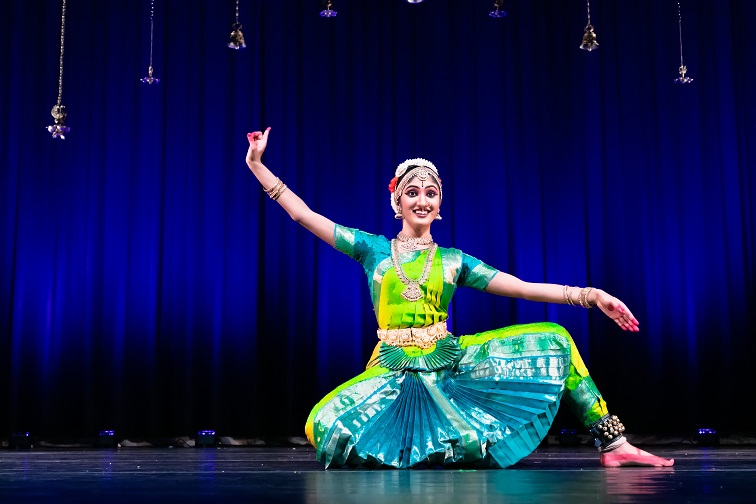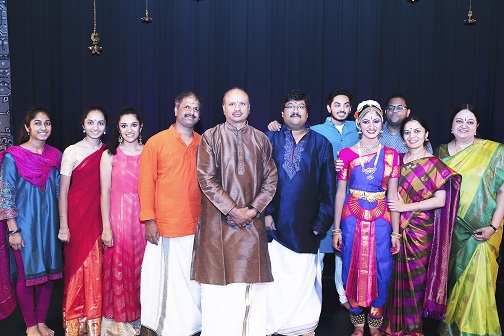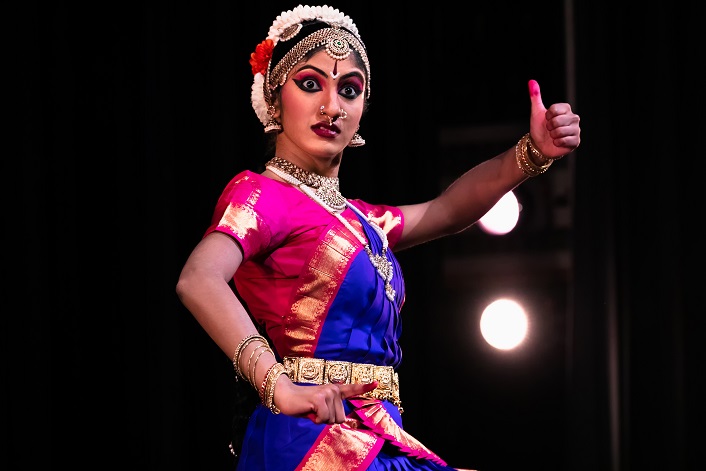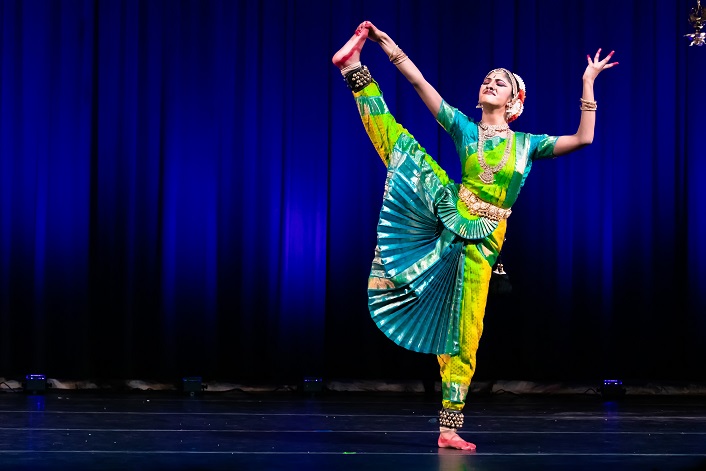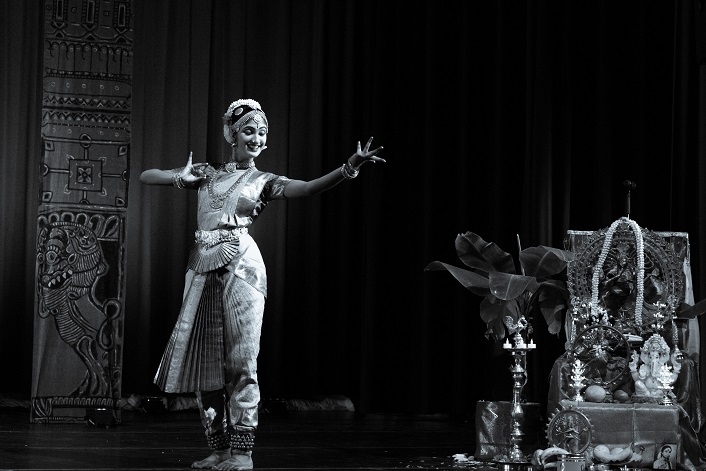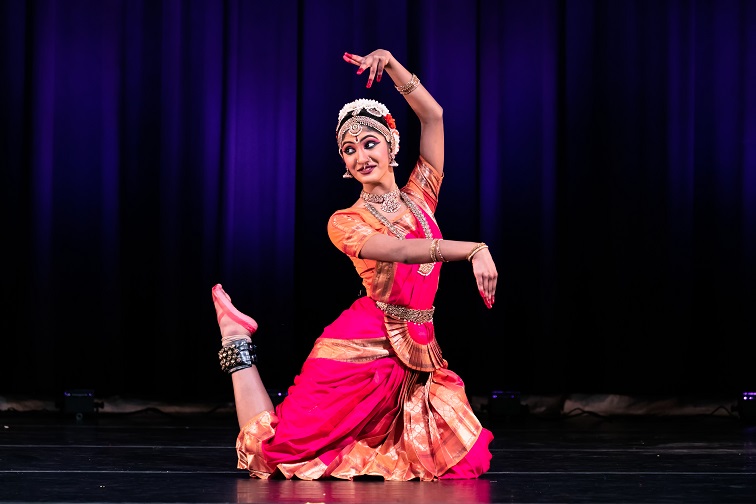Bharatanatyam Arangetram of Shanthni Ravindrababu
Yatho Hasthas Thatho Dhrishti (Where the Hands go, the Eyes should follow)
Yatho Dhrishtis Thatho Manaha (Where the Eyes go, the Mind should follow)
Yatho Manas Thatho Bhavaha (Where the Mind goes, the Psychological state should follow)
Yatho Bhavas Thatho Rasaha (Where the Psychological state goes, Sentiment arises) - Abhinaya Darpanam
The verse from Abhinaya Darpanam succinctly captures an impressive and memorable Bharatanatyam performance by Shanthni Ravindrababu, student of Natyamani School of Dance, Westboro and a rising senior from Shrewsbury High School who performed her Arangetram at Medway High School on July 7, 2018.
An orchestra of renowned musicians from India and the Boston area provided a divine musical milieu, while an elegant backdrop with suspended lamps between two columns recreated the scene of a mantapam from a typical ancient South Indian temple and added to the authenticity of the ambience.
The event started with a beautiful invocation of Lord Ganesha through the composition ‘Siddhi Vinayakam’ in raga Mohanakalyani by the vocalist Sri Mathur Srinidhi. The introduction of the dance performance began with a Pushpanjali in raga Gambheera Nattai. Adorned in a beautiful red and orange costume, Shanthni began her recital with graceful gestures of prayer and obeisance as she sought the blessings of the Divine, her guru, and the audience. The Pushpanjali seamlessly transitioned into the Ganesha Stuti ‘Sri Mahaganapathim Bhajeham’- a Jayachamaraja Wodeyar composition in raga Atana. Shanthni beautifully evoked the essence of this song describing the elephant-faced Lord Ganesha, even as she crisply navigated the fast-paced chittaiswarams interspersed in the piece.
The beautiful opening with the Pushpanjali and Ganesha Stuti set the stage for an energetic Jathiswaram in raga Khamas. Through the Jathiswaram, a pure nritta piece, Shanthni began to expertly display the Bharatanatyam skills she garnered over many years of dedication and commitment to learning the dance form. Guru Sridevi Ajai Thirumalai on the Nattuvangam added punch and power as Shanthni presented her choreography replete with rich rhythmic patterns and intricate footwork, evoking a sense of harmony and the joy of dance.
Shanthni then proceeded to display her skill in others aspects of Bharatanatyam, such as the nritya and natya. In the keerthana ‘Naanmughan Nayaki’ in raga Saraswati, Shanthni depicted Goddess Vaani as the Nayaki of Lord Brahma – the four-headed god of creation. Through the dance, one could visualize the Nada Swaroopini being seated on a white lotus throne bestowing knowledge to all those who seek her blessings.
The Varnam is the centerpiece of a Bharatanatyam performance. A detailed presentation, it serves to illustrate the vast repertoire of the art form in all its glorious “colors†by allowing the dancer to express their skill and mastery of the finer aspects of dance – such as nritta (pure dance), nrittya (interpretational dance) and abhinaya (expression). Shanthni presented ‘Devar Munivar’ in raga Shanmukhapriya, a composition of Sri Lalgudi Jayaraman to showcase her talent. This piece especially stood out long after the event concluded for its brilliant choreography of selected avataras of Lord Vishnu, for the crisp execution of the various intricate jathis that were interlaced in the song, and for the wonderfully expressive abhinaya. With much grace and aplomb, Shanthni depicted the stories of Kurma, Varaha, and Vamana avataras. The bhavas of the sancharis created by the flute and the violin accompaniments were truly divine and added flourish to Shanthni’s presentation – one felt transported to the scenes of the enticing Mohini, the churning of the milky ocean by the devas and asuras, Hiranyaksha's aggression, the rescue of the beleaguered Bhuma devi by the all-powerful Varaha, and of course the humbling of the mighty King Mahabali by Vamana. The depiction of Trivikraman in the anupallavi was the highlight of the piece, eliciting a sustained applause from the audience. This varnam was an electric conclusion to the first half of the arangetram.
The second half of the recital added further highlights to Shanthni’s coming of age as an accomplished student. It began with the popular and fast-paced ‘Yaar Adinar’, a composition of Madurai Sethuraman in raga Charukesi. While portraying the composer’s statement in the form of a question asking how anyone who has danced can ever match the grace and beauty of Lord Nataraja, Shanthni brilliantly held the various poses of Lord Shiva.
In a delightful ragamalika by Tanjavur Shankara Iyer called ‘Ranjani mala’ that followed, Shanthni elegantly portrayed Goddess Shakti as the Mother with eyes like tender lotus petals; as Megha Ranjani – the goddess of clouds caring for the afflicted; as Shoolini – the goddess with a Shoolam (trident) protecting the good; and as Jana Ranjani – the delight and inspiration of all the people.
A popular and upbeat Kavadi Chindu followed. Through ‘Pazhani Shanmugha Velundu’ composed by Arunagirinathar, Shanthini created a joyful atmosphere as she depicted Lord Muruga as the warrior prince with a spear slaying the demons to protect the devas. As the song concluded, Shanthni’s portrayal of the raising of the kavadi to the tempo of the music brought forth an imagery of throngs of devotees heading towards Pazhanimalai.
The thillana in raga Madhuvanti provided a fitting conclusion to the arangetram. In a composition praising Lord Krishna, Shanthni depicted a Nayaki describing how Krishna had stolen her heart. Just as this nritta-heavy piece helped the performance reach a crescendo, it underscored the role the orchestra had played creating the atmosphere that allowed Shanthni to showcase her talent. With her Nattuvangam, Guru Sridevi Ajai Thirumalai guided the young dancer throughout the performance to be in unison with the talam. Vidwan Mathur Srinidhi’s brilliant singing provided the musical canvas on which Shanthni painted her wonderful performance. Vidwan Narasimhamurthy Ramamishra on the flute, Vidwan Srihari Rangaswamy on the Mridangam and Vidushi Tara Anand on the violin were the vibrant colors, each one of them showcasing their expertise and virtuosity at various times within each offering. Examples of this were the electric atmosphere they created as Shanthni depicted Trivikraman, the joyfulness in the Kavadi Chindu, and divinity in the Ranjani mala. Sri Sudarshan Thirumalai further enhanced the performance on the rhythm pad through his timely playing of temple bells, the conch, and many other musical effects that provided the rich dessert to the musical feast.
As Shanthni concluded the arangetram with a mangalam celebrating Lord Rama, she devotedly thanked Lord Nataraja, offered her gratitude to her guru and the orchestra, and expressed her thanks to the audience who at this time were standing in awe and applauding in sustained appreciation of an excellent performance.
Shanthni had done her guru proud. She had done her parents proud. And, she had done Ramya Ravindrababu, her older sister and the M.C of the evening, proud. Ramya, herself a student of Guru Sridevi, had done a wonderful job guiding the audience through the evening with insightful remarks at the beginning of each dance piece.
As Guru Sridevi remarked in her speech, the “arangetram is just the beginningâ€. We hope to see Shanthni continue to explore this art form, and wish her the very best all along her journey.
